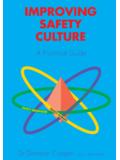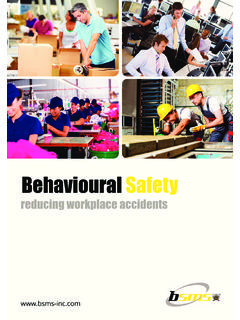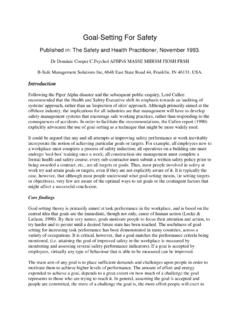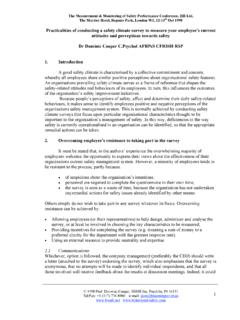Transcription of Human Factors in Accidents - Behavior-based safety
1 "Revitalising Health and safety - achieving the Hard Target".Institute of Quarrying, North Of England- CoalPro Seminar, Ramside Hall, Durham, UK. 12 March 2002 2002 Prof. Dominic Cooper, BSMS Inc, Franklin, IN, 46131, USA / Fax: +1 (317) 346 8980 e-mail: & 1 Human Factors in AccidentsProf. Dominic Cooper AFBPsS CFIOSH RSPBSMS Inc, Franklin, IN 46131 IntroductionMany organisations spend a lot of time and effort trying to improve safety . As well as addressing technical andhardware issues, many conduct safety management system audits to discover deviations from the performancestandards set in their Health & safety Policies.
2 Line-management is encouraged to conduct regular inspections ofthe workplace and employees are trained to behave safely and are given the appropriate protective equipment. Theimpact of such initiatives could be seen in the overall downward trend in accident statistics from 1990 to 1998 the last two years, however, accident statistics are rising in many UK industrial sectors. In the QuarryIndustry, for example, there has been a 60% rise in the number of fatalities (HSC, 2001). We need to ponder whythis is happening at a time when the industry is focusing its efforts at revitalising Health & safety to create apositive safety CultureGaining international currency over the last decade, the term safety Culture is loosely used to describe thecorporate atmosphere or culture in which safety is understood to be, and is accepted as, the number one priority (Cullen,1990).
3 Unless safety is the dominating characteristic of corporate culture, which arguably it should be in high-riskindustries, safety culture is a sub-component of corporate culture, which alludes to individual, job, and organizationalfeatures that affect and influence health & safety . As such the dominant corporate culture and the prevailing context suchas downsizing, organizational restructuring ( Pierce, 1998) will exert a considerable influence on its developmentand vice-versa as both inter-relate and reinforce each other ( Williams, 1991). This illustrates that safety culture doesnot operate in a vacuum: It affects, and in turn is affected by, other operational processes, organizational systems and/orsocietal events (Cooper et al, 1994, Pidgeon, 1998).
4 By way of example, top-level decision-makers have to deal withexternal influences ( excessive aggregate taxes) if they are to steer their organisations to success. Although a 50%increase in safety performance can lead to a 12% increase in productivity (Stewart & Townsend, 2000) many company snarrowly concentrate on economic Factors ( Cost control, Increased production targets, Downsizing, Mergers &Acquisitions) in attempts to overcome the Factors creating the adverse economic climate. Ironically, this can lead to theinadvertent introduction of accident causing pathogens into the organisation, resulting in an increased incident/accidentrate, which in turn increases costs and reduces Causation ChainsThis becomes more apparent when theoretical models of accident causation are examined (See Cooper 2001bfor a detailed overview).
5 The most influential of these is Heinrich s Domino model (See Heinrich et al. 1980; Weaver,1971; Adams, 1976 ; Reason, 1990). While Heinrich concluded that the key domino was that pertaining to unsafe acts,Weaver (1971) focused on symptoms of operational error (management omissions) that interact with unsafe acts and/orconditions. Adams (1976) emphasised that operational errors were caused by the Management structure; Management sobjectives; the Synchronisation of the workflow system; and How operations were planned and executed. In turn theseoperational errors caused 'tactical errors' (unsafe acts or conditions). Reason (1990) also shifts the main focus of accidentprevention away from unsafe acts and more onto the organization s management systems.
6 In conjunction with JohnWreathall, Reason (1993) aligned Heinrich s domino model with a parallel five element production model andidentified how and where latent and active safety failures (termed pathogens ) might be introduced into organizationalsystems (See figure 1). Reason asserts that both latent and active failures are introduced by organisational or managerialfactors ( top-level decision-making), but individuals ( psychological or behavioral precursors) trigger the activefailures. The evidence supporting these assertions is overwhelming and is drawn from a diverse range of industrialsectors such as commercial aviation, nuclear power generation, process plants, railways, marine operations, financialservices and healthcare institutions (Reason, 1998).
7 Support can also be drawn from the quarrying industry. Forexample, in the UK, quarries are often hampered by a lack of space imposed by population density, housing androads. Because of this it is often very difficult to achieve ideal road layouts, in terms of gradients, road widths,cambers, escape roads, etc., (latent failures). Equally, this causes other difficulties for site managers to ensure thatvehicles and pedestrians are kept clear of operational areas, while traffic congestion is kept to the absoluteminimum. However, despite these difficulties, many companies continue to attempt to maximise cost/benefitratios, by using extremely large vehicles, often with payloads anywhere between 50 - 100 tonnes.
8 Unfortunately asthey need a lot of space to manoeuvre safely these vehicles are often unsuitable for the prevailing conditions (latentfailure)."Revitalising Health and safety - achieving the Hard Target".Institute of Quarrying, North Of England- CoalPro Seminar, Ramside Hall, Durham, UK. 12 March 2002 2002 Prof. Dominic Cooper, BSMS Inc, Franklin, IN, 46131, USA / Fax: +1 (317) 346 8980 e-mail: & 2 Figure 1: Adaptation of Reason & Wreathall s pathogen modelIn addition, these larger vehicles tend to have a much greater number of driver blind spots , particularly at the rear(latent failure).
9 Thus the choice of vehicle, for the space available can inadvertently introduce a number of latentfailures or pathogens . Should the driver of such a vehicle attempt to manoeuvre in reverse without visual aids or a traffic controller (an active failure), relying instead solely on automatic reversing audible and visual alertingsignals, the drivers actions and the pathogens (size of vehicle and blind spots) could combine to trigger anaccident: Either colliding with another vehicle or fatally injuring a pedestrian. Just to show the problems faced bydrivers of such vehicles, can you see the person standing next to the white truck in the round mirror in thepicture below?
10 Figure 2: Drivers view from the cab of a large vehicleThe photo example also illustrates a further aspect of Human Factors in Accidents that reflects the concept of safetyculture, and that is the relationship between people s perceptions of the situation and the influences of these on theirsubsequent behaviour. I do not know about you, but I could not see the person standing by the white vehicle. Assuch, as the driver I would continue to reverse (behaviour) in the belief (perception) that it was safe to do so High-leveldecision makersLinemanagementimplementationSystem ic PathogensPreconditions:People, Technology& EquipmentSynchronised productive activitiesDefences &protectivemeasuresLossFallible decisionsLine managementdeficienciesPreconditions.




